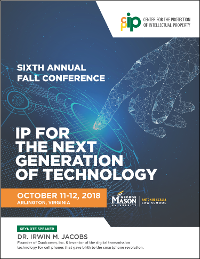The following post comes from Jack Ring, a rising 2L at Scalia Law and a Research Assistant at C-IP2.
 I. INTRODUCTION
I. INTRODUCTION
In a previous blog post, we discussed the dispute surrounding standard essential patents (SEPs) between Philips and Thales. That dispute included an investigation before the United States International Trade Commission (ITC).[1] As part of that investigation, Chair Lina Khan and Commissioner Rebecca Slaughter of the Federal Trade Commission (FTC) submitted a public interest statement to the ITC (Public Interest Statement or Statement).[2] Commissioner Christine Wilson responded to the Statement in a speech at the “IP & Antitrust: Hot Issues” Conference Organized by Concurrences Review (Response or Remarks).[3]
These competing statements by FTC commissioners illustrate a point of contention regarding SEP policy. The Public Interest Statement, submitted by Chair Khan and Commissioner Slaughter, took a policy stance that an exclusion order against an SEP implementer unfairly favors the SEP holder. Meanwhile, Commissioner Wilson’s Response countered that this policy instead tips the balance heavily in favor of implementers, which in her opinion could stifle SEP-holder innovation. This dichotomy of policy goals underlays some of the decisions discussed in the previous blog post about the Philips v. Thales appeal. There, Chief Judge Colm Connolly of the United States District Court for the District of Delaware avoided making policy in his decision, explicitly reserving that for a higher court.[4] The ITC’s Commission opinion in the ITC Investigation took no position on many issues, potentially to avoid tackling these tough issues.[5] And finally, the Federal Circuit affirmed Chief Judge Connolly’s order on the narrowest grounds, likewise sidestepping the policy concerns debated in the Public Interest Statement and Response.[6]
Additionally, as Commissioner Wilson’s Remarks note, Apple and Ericsson are now involved in SEP litigation spanning U.S. courts, international courts, and the ITC.[7] This will once again provide ample opportunity for multiple jurisdictions, including the ITC, to weigh these policy and public interest concerns.
II. CHAIR KHAN AND COMMISSIONER SLAUGHTER’S PUBLIC INTEREST STATEMENT
Chair Khan and Commission Slaughter’s Statement advanced a broad policy argument through the lens of an “increasing[] concern that SEP holders . . . are seeking exclusionary orders . . . for the purpose of gaining leverage.” Through that lens, the Public Interest Statement sought to answer the question, “Is it in the public interest to issue an ITC exclusion order based on a standard essential patent (SEP) where a United States district court has been asked to determine fair, reasonable, and non-discriminatory (FRAND) licensing terms?” Answering its own posed question, the Statement urged the ITC to consider the statutory public interest factors[8] with particular attention to the impact an exclusion order obtained by a SEP owner against an SEP implementer would have on competition and consumers in the United States.
Chair Khan and Commissioner Slaughter’s concern focuses heavily on misconduct—hold-up—by SEP owners. Hold-up refers to an SEP holder’s demand for a royalty rate in excess of a FRAND rate after an implementer is locked into the standard. Alternatively, hold-out refers to an implementer’s bad faith delaying of constructive licensing negotiations or unilaterally rejecting of a license.
The Public Interest Statement argues that an SEP owner seeking an exclusion order of SEPs at the ITC perpetuates an imbalance in bargaining power. Chair Khan and Commissioner Slaughter recognize that opportunism may arise from either side, but they view an exclusion order as granting unfair leverage for an SEP holder. This one-sided view was discussed by Commissioner Wilson in her Response and will be discussed below.
The Public Interest Statement further recognized the ITC’s enforcement role in intellectual property rights and the ITC’s view on that enforcement in footnote twelve. However, Chair Khan and Commissioner Slaughter argue that SEPs present different issues than other patents. In their opinion, a royalty negotiation under threat of an exclusion order tips the scale in favor of the SEP owner, who made a FRAND commitment—a commitment that may have helped them get the standardization in the first place. In their view, the exclusion of firms that are willing and able to take FRAND licenses discourages investment in standard driven products and technology.
Additionally, hidden in the first footnote, the Statement declined to address whether “seeking an exclusion order for FRAND-encumbered SEPs would violate Section 5 of the Federal Trade Commission Act.” Section 5 of the FTC act covers unfair acts and practices. If the FTC began enforcing Section 5 against SEP owners seeking exclusion orders in the ITC, that would have some of the most drastic short-term changes in SEP policy. Whether that short-term policy change would stand up to judicial review or be the best policy for cultivating innovation remains to be seen.
The Public Interest Statement ultimately moves on to a larger policy rejecting exclusion orders—the only remedy available from the ITC—whenever a court has been asked to set FRAND terms and can make SEP holders whole. (“As a general matter, exclusionary relief is incongruent and against the public interest where a court has been asked to resolve FRAND terms and can make the SEP holder whole.”) In closing, the Public Interest Statement urges the ITC to take its advice that “under no circumstances should Section 337 remedies . . . take effect” until a court asked to resolve the FRAND rate has rendered its decision.
III. COMMISSIONER WILSON’S RESPONSE
Shortly after Chair Khan and Commissioner Slaughter filed their Statement, Commissioner Wilson of the FTC responded with her own critiques. Her Response recognized the same issues but approached those issues from a balancing standpoint. The Response advocated for weighing the rights of SEP holders and implementers and considering both short- and long-term goals.
Commissioner Wilson expressed concern that Chair Khan and Commissioner Slaughter only view hold-up as an antitrust issue. (“In other words, the actions of SEP holders may be unlawful under the antitrust laws, but the actions of patent implementers are immune from scrutiny under those same laws.”) Commissioner Wilson’s Remarks generally pushed the FTC to embrace a balanced approach that favors neither innovators nor implementers but instead focused on incentivizing competition and innovation.
Responding directly to the Public Interest Statement’s call for the ITC to reject exclusion orders where a court has been asked to set FRAND rates, Commissioner Wilson reasoned that the ITC’s public interest analysis already accounts for this type of analysis. Quoting an article from former ITC commissioner and chair Deanna Tanner Okun, the Response explained that the ITC’s public interest factors and process allow allegedly infringing parties the opportunity to argue the SEP holder violated its commitments to the standard setting organization[9] (the point being, why set a blanket prohibition on exclusion orders when the ITC’s processes already account for considering multiple factors in its public interest analysis?).
Commissioner Wilson’s Remarks also touched on the Apple and Ericsson SEP litigation presently occurring in multiple venues, including the ITC. Those proceedings offer another chance for the ITC to consider the Statement and Response’s policy arguments. However, as Commissioner Wilson flagged, unlike in the Philips proceedings, Apple has not committed to accepting the District Court’s FRAND rate. Apple’s non-commitment could be evidence of hold-out, which Commissioner Wilson specifically raised in her Remarks. This change in the fact pattern from the Philips/Thales dispute illustrates how complex and fact-specific SEP proceedings can be.
At bottom, the Response is concerned that the Public Interest Statement’s proposal would tip the balance in favor of SEP implementers when—in Commissioner Wilson’s view—there should be no thumb on the scale. The Response expressed concern with adoption of a one-size-fits-all approach of denying exclusion orders at the ITC whenever a court has been asked to set a FRAND rate. Rather, she posits that the ITC’s public interest factors anticipated complex litigations like those discussed above. Therefore, by the time a case has reached the final stages at the ITC, the Commission or administrative law judge has the necessary information to evaluate the public interest.
IV. TAKEAWAYS
These two policy proposals from FTC commissioners illustrate the complexity of the SEP policy debate, particularly regarding exclusion orders at the ITC. Moving forward, the Apple and Ericsson disputes in multiple courts including the ITC will provide another opportunity for multiple forums to grapple with these competing policies.
[1] Certain UMTS & LTE Cellular Communications Modules & Products Containing the Same, Inv. No. 337-TA-1240 (USITC).
[2] Written Submission on the Public Interest of Federal Trade Commission Chair Lina M. Khan and Commissioner Rebecca Kelly Slaughter, in the Matter of Certain UMTS and LTE Cellular Communication Modules and Products Containing the Same, Inv. No. 337-TA-1240 (USITC May 16, 2022),
https://www.ftc.gov/system/files/ftc_gov/pdf/Written_Submission_on_the_Public_Interest_if_Chair_Khan_and_Co mmissioner_Slaughter_to_ITC.pdf.
[3] Christine Wilson, Comm’r, Fed. Trade Comm’n, Remarks at “IP & Antitrust: Hot Issues” Conference Organized by Concurrences Review (June 8, 2022), https://www.ftc.gov/system/files/ftc_gov/pdf/Wilson-SEPs-speech_FINAL-06-13-2022.pdf.
[4] Koninklijke Philips N.V. v. Thales DIS AIS USA LLC, C.A. 20-1713 (D. Del. May 21, 2021).
[5] Certain UMTS & LTE Cellular Communications Modules & Products Containing the Same, Inv. No. 337-TA-1240, Comm’n Notice (USITC July 6, 2022) (EDIS No. 774681).
[6] Koninklijke Philips N.V. v. Thales DIS AIS USA LLC, No. 2021-2106 (Fed. Cir. July 13, 2022).
[7] Certain Mobile Telephones, Tablet Computers With Cellular Connectivity, & Smart Watches With Cellular Connectivity, Components Thereof, & Products Containing the Same, Inv. No. 337-TA-1299 (USITC).
[8] 19 U.S.C. §§ 1337(d)(1), (f)(1).
[9] Deanna Tanner Okun, Policy Shift Against SEP Rights Poses Risks for U.S. Innovation and Undermines Mandate of the ITC, IPWATCHDOG (May 18, 2022), https://www.ipwatchdog.com/2022/05/18/policy-shift-sep-rights-posesrisks-u-s-innovation-undermines-mandate-itc/id=149116/.
 By
By